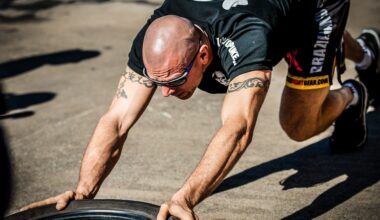Creating a Functional Training Muscle Building Routine
Designing a functional training muscle building routine involves combining traditional strength training with functional movements. This type of training enhances both strength and agility, vital for daily activities or athletics. A well-rounded routine focuses on muscle growth, while also developing strength and coordination. Start by selecting compound exercises that target multiple muscle groups. Squats, deadlifts, and bench presses are foundational compound exercises. Moreover, functional movements like kettlebell swings and TRX rows help build muscle while improving dynamic stability. They mimic real-life activities, making the workout beneficial beyond aesthetics. Integrating balance exercises, such as single-leg lifts or stability ball routines, enhances core strength. Additionally, emphasize mobility training through dynamic stretches and foam rolling, ensuring muscles recover efficiently for future sessions. Aim to work out four to five times a week, incorporating rest days to allow muscles to repair and grow stronger. Remember that progressive overload is crucial for muscle development. Gradually increase weights or resistance over time. Proper nutrition, including proteins and carbohydrates, will further support muscle recovery. This holistic approach ensures your functional training routine is effective and builds lasting muscle strength and tone.
Key Functional Exercises
Incorporating key functional exercises is essential for a successful muscle building routine. Focus on exercises that mimic everyday movements, promoting strength and coordination. Deadlifts are excellent for posterior chain development; they target lower back, glutes, and hamstrings. Squats, especially variations such as front squats or goblet squats, emphasize leg and core strength. Engage in overhead presses to increase shoulder stability and upper body power. Rows, including bent-over rows and inverted rows, are pivotal for building back strength. Incorporate push-up variations to enhance chest and tricep development, encouraging functional upper body strength. Lunges are another great addition, as they challenge balance and synergistic muscle coordination. Movements targeting the core, like planks or rotational exercises, should also be included because a strong core supports all other lifts. Functional training focuses on multi-directional movement, hence lateral exercises like side lunges or lateral raises should be added. Make sure to vary between high-intensity interval training (HIIT) and lower rep strength workouts for optimal results. This balanced approach ensures muscles engage differently, leading to strength and hypertrophy improvements, making workouts both challenging and rewarding.
To maximize the effectiveness of your efforts, implementing a structured routine with set goals is crucial. Before starting, assess your personal fitness level, which allows you to design a program that matches your experience and capability. Next, outline specific short-term and long-term goals. Short-term goals might involve exercises completion, while long-term goals could focus on weightlifting targets or muscle growth objectives. It’s recommended to maintain records of workouts, tracking progress weekly or bi-weekly, to analyze improvements. Individualizing the routine based on your needs is also vital. Customization allows you to incorporate your favorite exercises, making workouts enjoyable and engaging. Periodization is another effective strategy, including cycles of varying intensity and workload. This method prevents plateaus and minimizes injury risk, adjusting focus periodically among strength, hypertrophy, and endurance. At least once every few weeks, reassess and adjust your routine based on your progress and feedback. It’s also essential to stay consistent and committed. On days when motivation wanes, remind yourself of your goals. Incorporate techniques like visualization and positive affirmations to maintain your drive and dedication towards building muscle and enhancing overall fitness.
Nutritional Support for Muscle Building
Nutrition is a critical component of any functional training muscle building routine, as it fuels your body for workouts, recovery, and muscle development. Prioritize a protein-rich diet as it aids muscle repair and growth. Aim for at least one gram of protein per pound of body weight, including high-quality sources such as lean meats, fish, eggs, and plant-based proteins. Additionally, incorporate complex carbohydrates for energy, sourcing from whole grains, fruits, and vegetables. These nutrients provide the necessary fuel for intense workouts. Healthy fats, found in avocados, nuts, and olive oil, support overall energy levels while providing essential fatty acids your body needs. Stay properly hydrated, especially during workouts. Dehydration can severely hinder performance and recovery. Consider meal timing as part of your strategy; consuming a protein and carb-rich meal or snack within an hour after training is beneficial for muscle recovery. Supplementation can also be useful in certain cases. Consult a nutritionist to determine if supplements, like whey protein or creatine, could further enhance your progress. Understanding your unique nutritional needs will ensure your body receives the correct fuel to support your functional training muscle building efforts.
Recovery is often overlooked, but it is indispensable to muscle building and functional training. Without adequate recovery, muscles can experience fatigue, leading to poor performance and potential injury. To optimize recovery, prioritize sleep, aiming for at least seven to eight hours nightly. Quality sleep fosters muscle repair and overall health. Listen to your body; if you feel excessively sore or fatigued, consider incorporating active recovery days filled with light activities such as walking or yoga. Foam rolling or using a massage gun can also alleviate muscle tension and expedite recovery. Stretching before and after workouts is essential, enhancing flexibility and preventing soreness. Rotating muscle groups during training sessions helps as well, allowing muscle groups time to recover adequately. Proper hydration is also crucial; water plays a vital role in muscle recovery and overall performance. Implementing relaxation techniques, like meditation or deep breathing, can further reduce stress and enhance recovery. Mental wellness directly impacts physical performance. Establishing a balanced routine of intense workouts and ample recovery will ensure you build muscle effectively while promoting overall health and well-being.
Tracking Progress
Effective tracking of your progress in functional training is essential for motivation and continuous improvement. Keeping a detailed workout journal helps evaluate gains and setbacks. Document the weights lifted, repetitions completed, and any notes regarding how you felt during the workout. Utilize fitness apps or spreadsheets to streamline the process, allowing for a more comprehensive view of your performance over time. Set measurable milestones within your overarching goals, such as increasing your squat by 20 pounds within two months. These smaller, achievable targets can keep you motivated as you notice progress along the way. Additionally, consider taking progress photos every few weeks. Visuals can have a significant impact on motivation, showcasing physical changes you may not notice daily. Regularly reassess your workout plan based on your recorded progress, adjusting intensity or exercise selection to avoid plateaus. Remember to also include subjective components of progress, like energy levels and well-being. A balanced approach considers both objective measures and personal feelings regarding your training. Consistent evaluation will help ensure you’re making the necessary adjustments to maximize your efforts and continue building muscle effectively.
In conclusion, creating a functional training muscle building routine is a comprehensive process requiring thoughtful planning and execution. Emphasizing key functional exercises while maintaining consistency is crucial for achieving desired results. Nutritional support cannot be understated; proper fueling plays an integral role in performance and recovery. Moreover, understanding the significance of recovery is essential in preventing burnout and injuries. Utilize tracking methods to monitor progress effectively, making necessary adjustments to stay on target with programs as you advance. Remember to customize your workouts to accommodate your preferences, keeping your training enjoyable. Employing varied strategies prevents mental fatigue and encourages sustained motivation. Finally, maintaining a focus on overall wellness, including mental health, is vital for long-term success in fitness endeavors. As you follow this blueprint for functional training muscle building, remain patient and committed. Progress takes time. Celebrate small victories along your journey, reinforcing your dedication and determination. Stay informed about your body’s responses and remain flexible in tweaking your routine as required. This holistic strategy ensures both enjoyment and tangible results, fostering a robust functional training muscle building routine that will enhance your life and fitness.



